T1 2019 BN208: OpManager Application Assessment for Network Management
VerifiedAdded on 2022/12/19
|8
|1884
|63
Report
AI Summary
This report evaluates the OpManager application, focusing on its capabilities in network management, monitoring, and configuration. It begins by outlining the challenges of managing modern networks and then delves into OpManager's functionalities, including real-time network monitoring and the monitoring of both physical and virtual servers. The report highlights the benefits of these features, detailing the processes involved in operating and managing both virtual and physical server environments. Furthermore, it examines OpManager's adherence to socio-technical principles and concludes with a discussion of its overall effectiveness in addressing network management needs. The report also mentions a past vulnerability in the application.

Running head: OPMANAGER APPLICATION ASSESSMENT
OpManager Application Assessment
Name of the Student
Name of the University
Author Note
OpManager Application Assessment
Name of the Student
Name of the University
Author Note
Paraphrase This Document
Need a fresh take? Get an instant paraphrase of this document with our AI Paraphraser

1
OPMANAGER APPLICATION ASSESSMENT
Summary
The purpose of this report is to list the challenges in managing, monitoring and configuring
networks with network management software applications and how OpManager can
perform the necessary functions in managing a given network. After discussing the
requirements from the application in the problem statement, the literature review section
starts where the functionalities of OpManager are detailed and how the socio technical
principles are adhered to get mentioned. The functionalities are mainly about real time
monitoring of networks and monitoring of physical and virtual servers. The benefits of both
the aspects get discussed in detail as the set of monitoring functionalities are listed and the
process of operating and running virtual as well as physical servers. After discussing the
socio technical adherence of OpManager, the report ends with concluding notes.
OPMANAGER APPLICATION ASSESSMENT
Summary
The purpose of this report is to list the challenges in managing, monitoring and configuring
networks with network management software applications and how OpManager can
perform the necessary functions in managing a given network. After discussing the
requirements from the application in the problem statement, the literature review section
starts where the functionalities of OpManager are detailed and how the socio technical
principles are adhered to get mentioned. The functionalities are mainly about real time
monitoring of networks and monitoring of physical and virtual servers. The benefits of both
the aspects get discussed in detail as the set of monitoring functionalities are listed and the
process of operating and running virtual as well as physical servers. After discussing the
socio technical adherence of OpManager, the report ends with concluding notes.
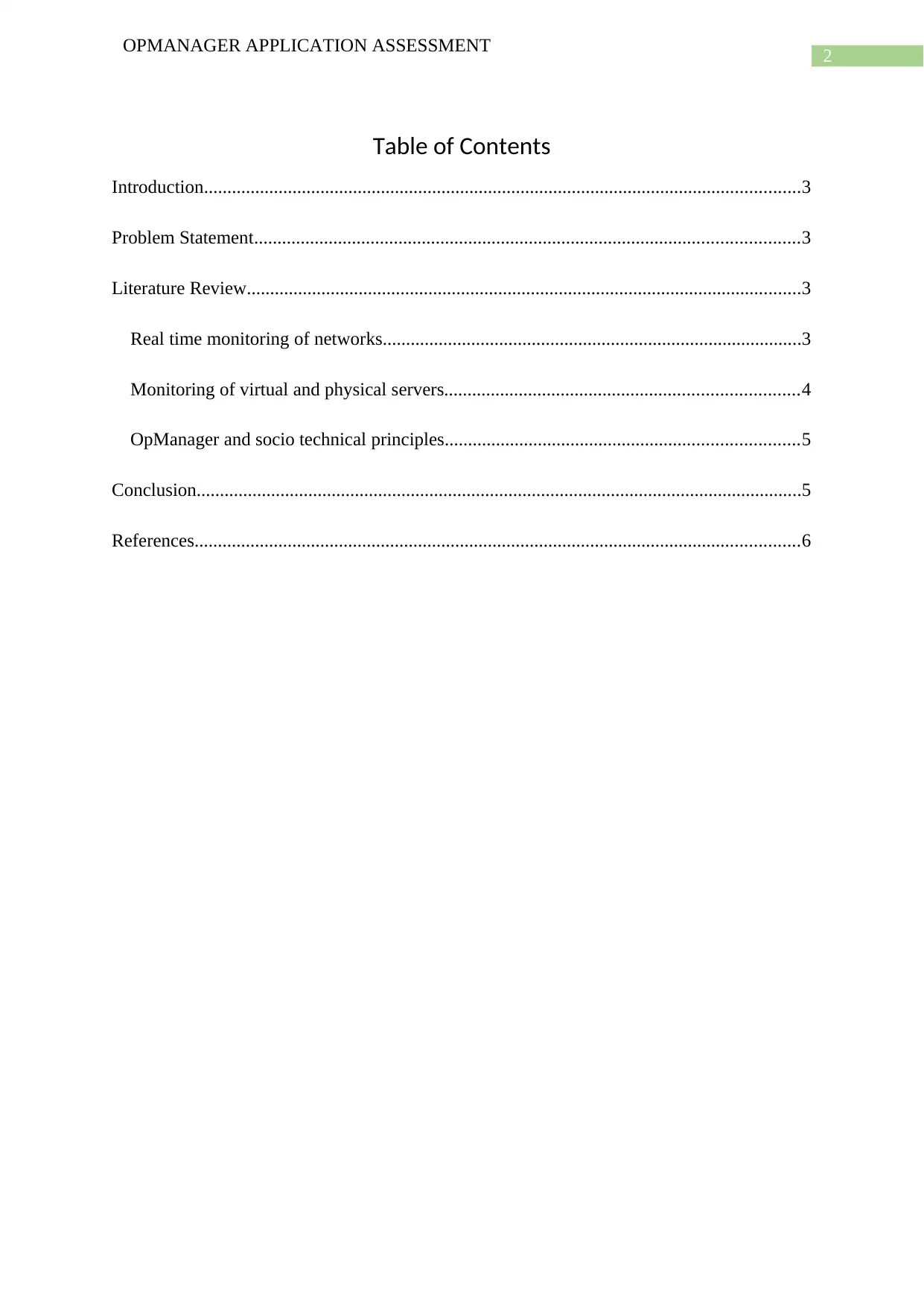
2
OPMANAGER APPLICATION ASSESSMENT
Table of Contents
Introduction................................................................................................................................3
Problem Statement.....................................................................................................................3
Literature Review.......................................................................................................................3
Real time monitoring of networks..........................................................................................3
Monitoring of virtual and physical servers............................................................................4
OpManager and socio technical principles............................................................................5
Conclusion..................................................................................................................................5
References..................................................................................................................................6
OPMANAGER APPLICATION ASSESSMENT
Table of Contents
Introduction................................................................................................................................3
Problem Statement.....................................................................................................................3
Literature Review.......................................................................................................................3
Real time monitoring of networks..........................................................................................3
Monitoring of virtual and physical servers............................................................................4
OpManager and socio technical principles............................................................................5
Conclusion..................................................................................................................................5
References..................................................................................................................................6
⊘ This is a preview!⊘
Do you want full access?
Subscribe today to unlock all pages.

Trusted by 1+ million students worldwide
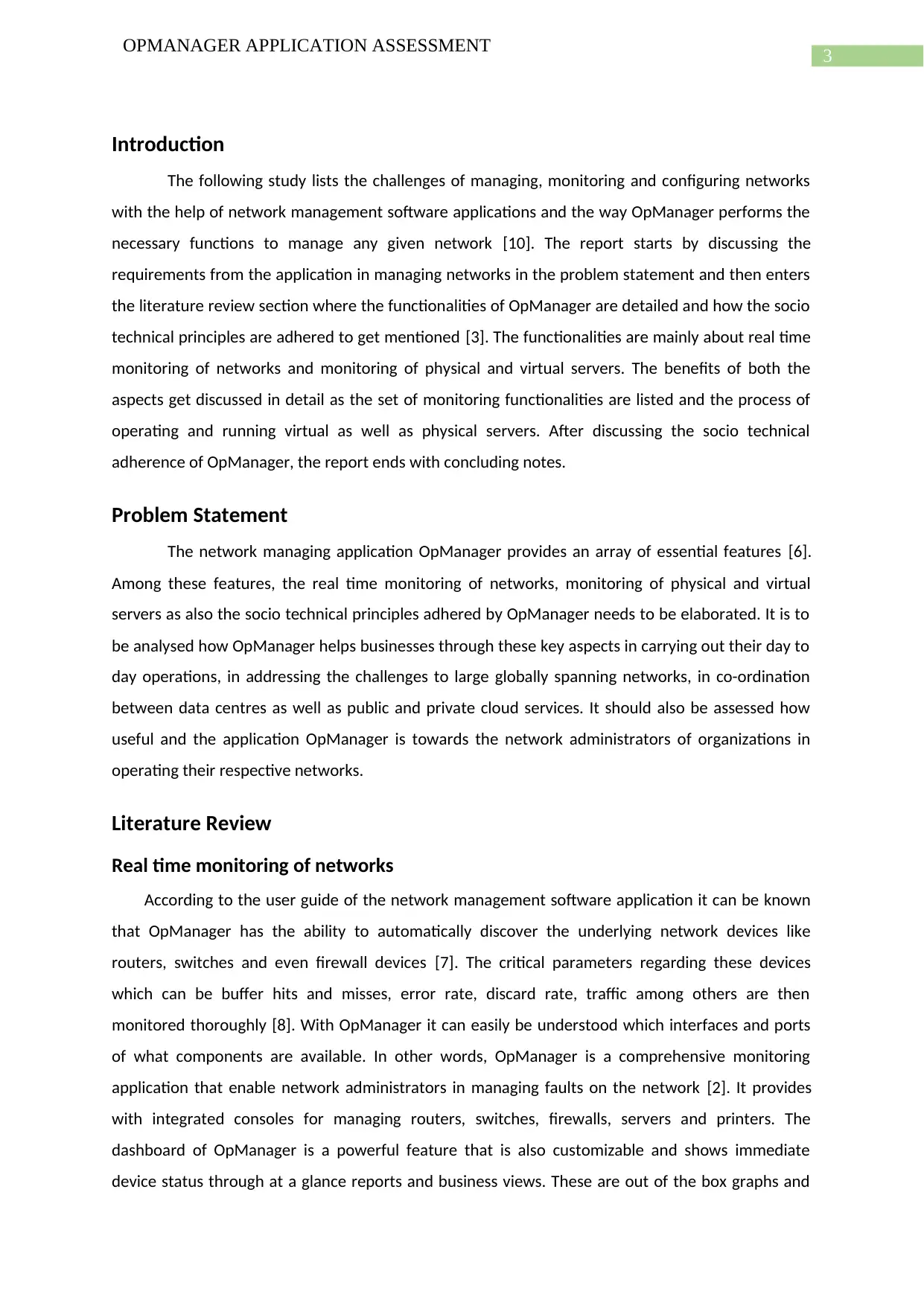
3
OPMANAGER APPLICATION ASSESSMENT
Introduction
The following study lists the challenges of managing, monitoring and configuring networks
with the help of network management software applications and the way OpManager performs the
necessary functions to manage any given network [10]. The report starts by discussing the
requirements from the application in managing networks in the problem statement and then enters
the literature review section where the functionalities of OpManager are detailed and how the socio
technical principles are adhered to get mentioned [3]. The functionalities are mainly about real time
monitoring of networks and monitoring of physical and virtual servers. The benefits of both the
aspects get discussed in detail as the set of monitoring functionalities are listed and the process of
operating and running virtual as well as physical servers. After discussing the socio technical
adherence of OpManager, the report ends with concluding notes.
Problem Statement
The network managing application OpManager provides an array of essential features [6].
Among these features, the real time monitoring of networks, monitoring of physical and virtual
servers as also the socio technical principles adhered by OpManager needs to be elaborated. It is to
be analysed how OpManager helps businesses through these key aspects in carrying out their day to
day operations, in addressing the challenges to large globally spanning networks, in co-ordination
between data centres as well as public and private cloud services. It should also be assessed how
useful and the application OpManager is towards the network administrators of organizations in
operating their respective networks.
Literature Review
Real time monitoring of networks
According to the user guide of the network management software application it can be known
that OpManager has the ability to automatically discover the underlying network devices like
routers, switches and even firewall devices [7]. The critical parameters regarding these devices
which can be buffer hits and misses, error rate, discard rate, traffic among others are then
monitored thoroughly [8]. With OpManager it can easily be understood which interfaces and ports
of what components are available. In other words, OpManager is a comprehensive monitoring
application that enable network administrators in managing faults on the network [2]. It provides
with integrated consoles for managing routers, switches, firewalls, servers and printers. The
dashboard of OpManager is a powerful feature that is also customizable and shows immediate
device status through at a glance reports and business views. These are out of the box graphs and
OPMANAGER APPLICATION ASSESSMENT
Introduction
The following study lists the challenges of managing, monitoring and configuring networks
with the help of network management software applications and the way OpManager performs the
necessary functions to manage any given network [10]. The report starts by discussing the
requirements from the application in managing networks in the problem statement and then enters
the literature review section where the functionalities of OpManager are detailed and how the socio
technical principles are adhered to get mentioned [3]. The functionalities are mainly about real time
monitoring of networks and monitoring of physical and virtual servers. The benefits of both the
aspects get discussed in detail as the set of monitoring functionalities are listed and the process of
operating and running virtual as well as physical servers. After discussing the socio technical
adherence of OpManager, the report ends with concluding notes.
Problem Statement
The network managing application OpManager provides an array of essential features [6].
Among these features, the real time monitoring of networks, monitoring of physical and virtual
servers as also the socio technical principles adhered by OpManager needs to be elaborated. It is to
be analysed how OpManager helps businesses through these key aspects in carrying out their day to
day operations, in addressing the challenges to large globally spanning networks, in co-ordination
between data centres as well as public and private cloud services. It should also be assessed how
useful and the application OpManager is towards the network administrators of organizations in
operating their respective networks.
Literature Review
Real time monitoring of networks
According to the user guide of the network management software application it can be known
that OpManager has the ability to automatically discover the underlying network devices like
routers, switches and even firewall devices [7]. The critical parameters regarding these devices
which can be buffer hits and misses, error rate, discard rate, traffic among others are then
monitored thoroughly [8]. With OpManager it can easily be understood which interfaces and ports
of what components are available. In other words, OpManager is a comprehensive monitoring
application that enable network administrators in managing faults on the network [2]. It provides
with integrated consoles for managing routers, switches, firewalls, servers and printers. The
dashboard of OpManager is a powerful feature that is also customizable and shows immediate
device status through at a glance reports and business views. These are out of the box graphs and
Paraphrase This Document
Need a fresh take? Get an instant paraphrase of this document with our AI Paraphraser
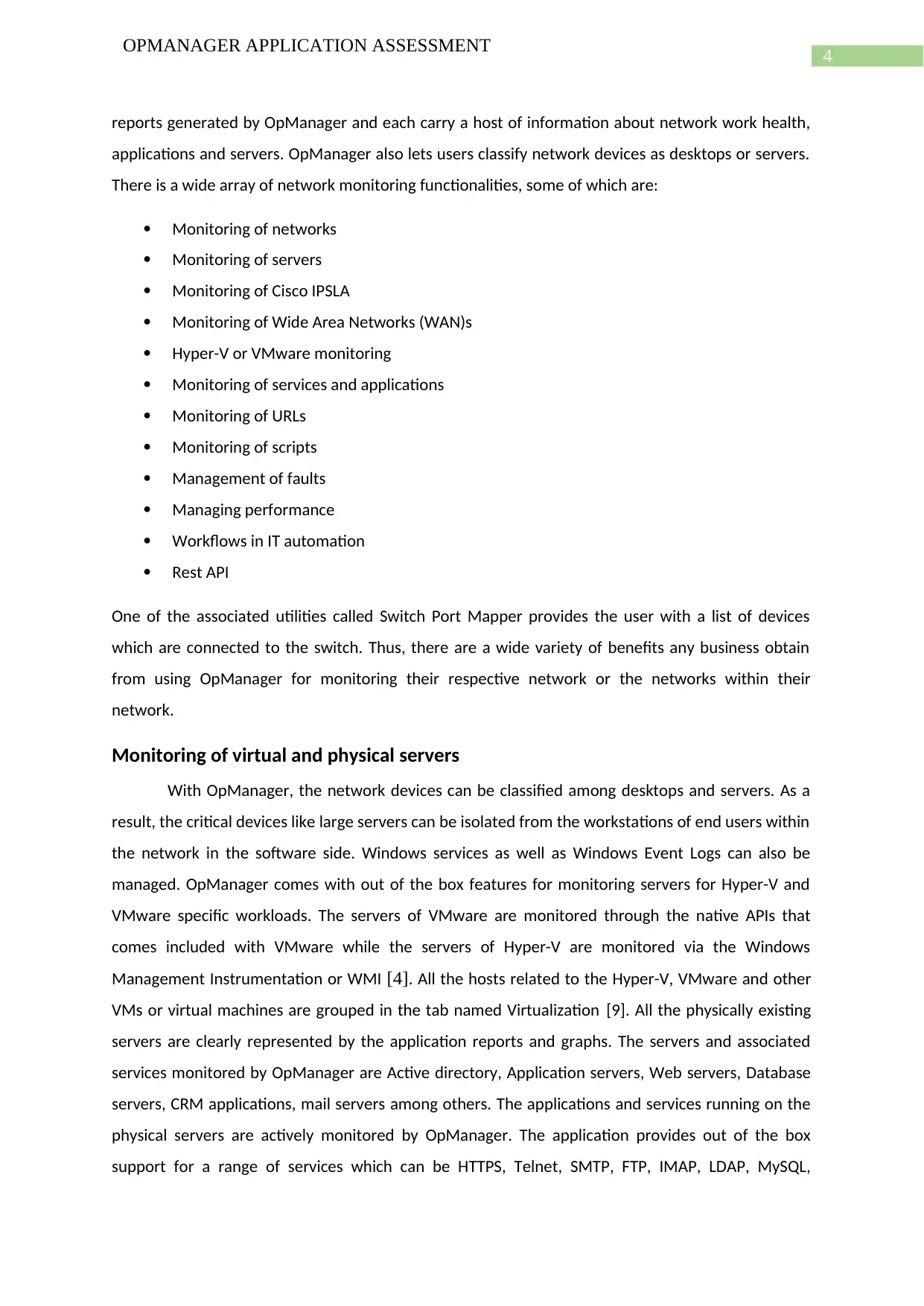
4
OPMANAGER APPLICATION ASSESSMENT
reports generated by OpManager and each carry a host of information about network work health,
applications and servers. OpManager also lets users classify network devices as desktops or servers.
There is a wide array of network monitoring functionalities, some of which are:
Monitoring of networks
Monitoring of servers
Monitoring of Cisco IPSLA
Monitoring of Wide Area Networks (WAN)s
Hyper-V or VMware monitoring
Monitoring of services and applications
Monitoring of URLs
Monitoring of scripts
Management of faults
Managing performance
Workflows in IT automation
Rest API
One of the associated utilities called Switch Port Mapper provides the user with a list of devices
which are connected to the switch. Thus, there are a wide variety of benefits any business obtain
from using OpManager for monitoring their respective network or the networks within their
network.
Monitoring of virtual and physical servers
With OpManager, the network devices can be classified among desktops and servers. As a
result, the critical devices like large servers can be isolated from the workstations of end users within
the network in the software side. Windows services as well as Windows Event Logs can also be
managed. OpManager comes with out of the box features for monitoring servers for Hyper-V and
VMware specific workloads. The servers of VMware are monitored through the native APIs that
comes included with VMware while the servers of Hyper-V are monitored via the Windows
Management Instrumentation or WMI [4]. All the hosts related to the Hyper-V, VMware and other
VMs or virtual machines are grouped in the tab named Virtualization [9]. All the physically existing
servers are clearly represented by the application reports and graphs. The servers and associated
services monitored by OpManager are Active directory, Application servers, Web servers, Database
servers, CRM applications, mail servers among others. The applications and services running on the
physical servers are actively monitored by OpManager. The application provides out of the box
support for a range of services which can be HTTPS, Telnet, SMTP, FTP, IMAP, LDAP, MySQL,
OPMANAGER APPLICATION ASSESSMENT
reports generated by OpManager and each carry a host of information about network work health,
applications and servers. OpManager also lets users classify network devices as desktops or servers.
There is a wide array of network monitoring functionalities, some of which are:
Monitoring of networks
Monitoring of servers
Monitoring of Cisco IPSLA
Monitoring of Wide Area Networks (WAN)s
Hyper-V or VMware monitoring
Monitoring of services and applications
Monitoring of URLs
Monitoring of scripts
Management of faults
Managing performance
Workflows in IT automation
Rest API
One of the associated utilities called Switch Port Mapper provides the user with a list of devices
which are connected to the switch. Thus, there are a wide variety of benefits any business obtain
from using OpManager for monitoring their respective network or the networks within their
network.
Monitoring of virtual and physical servers
With OpManager, the network devices can be classified among desktops and servers. As a
result, the critical devices like large servers can be isolated from the workstations of end users within
the network in the software side. Windows services as well as Windows Event Logs can also be
managed. OpManager comes with out of the box features for monitoring servers for Hyper-V and
VMware specific workloads. The servers of VMware are monitored through the native APIs that
comes included with VMware while the servers of Hyper-V are monitored via the Windows
Management Instrumentation or WMI [4]. All the hosts related to the Hyper-V, VMware and other
VMs or virtual machines are grouped in the tab named Virtualization [9]. All the physically existing
servers are clearly represented by the application reports and graphs. The servers and associated
services monitored by OpManager are Active directory, Application servers, Web servers, Database
servers, CRM applications, mail servers among others. The applications and services running on the
physical servers are actively monitored by OpManager. The application provides out of the box
support for a range of services which can be HTTPS, Telnet, SMTP, FTP, IMAP, LDAP, MySQL,
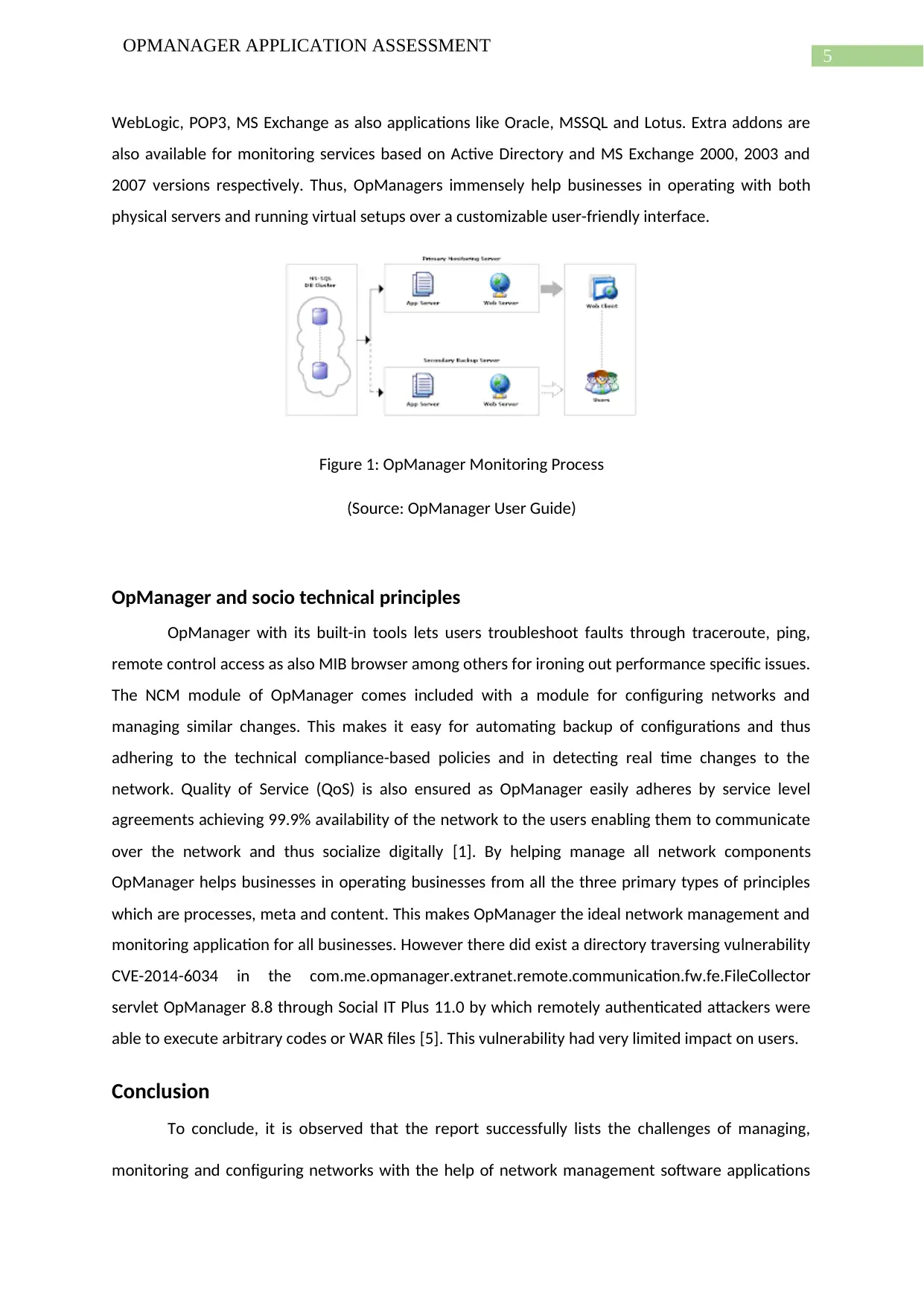
5
OPMANAGER APPLICATION ASSESSMENT
WebLogic, POP3, MS Exchange as also applications like Oracle, MSSQL and Lotus. Extra addons are
also available for monitoring services based on Active Directory and MS Exchange 2000, 2003 and
2007 versions respectively. Thus, OpManagers immensely help businesses in operating with both
physical servers and running virtual setups over a customizable user-friendly interface.
Figure 1: OpManager Monitoring Process
(Source: OpManager User Guide)
OpManager and socio technical principles
OpManager with its built-in tools lets users troubleshoot faults through traceroute, ping,
remote control access as also MIB browser among others for ironing out performance specific issues.
The NCM module of OpManager comes included with a module for configuring networks and
managing similar changes. This makes it easy for automating backup of configurations and thus
adhering to the technical compliance-based policies and in detecting real time changes to the
network. Quality of Service (QoS) is also ensured as OpManager easily adheres by service level
agreements achieving 99.9% availability of the network to the users enabling them to communicate
over the network and thus socialize digitally [1]. By helping manage all network components
OpManager helps businesses in operating businesses from all the three primary types of principles
which are processes, meta and content. This makes OpManager the ideal network management and
monitoring application for all businesses. However there did exist a directory traversing vulnerability
CVE-2014-6034 in the com.me.opmanager.extranet.remote.communication.fw.fe.FileCollector
servlet OpManager 8.8 through Social IT Plus 11.0 by which remotely authenticated attackers were
able to execute arbitrary codes or WAR files [5]. This vulnerability had very limited impact on users.
Conclusion
To conclude, it is observed that the report successfully lists the challenges of managing,
monitoring and configuring networks with the help of network management software applications
OPMANAGER APPLICATION ASSESSMENT
WebLogic, POP3, MS Exchange as also applications like Oracle, MSSQL and Lotus. Extra addons are
also available for monitoring services based on Active Directory and MS Exchange 2000, 2003 and
2007 versions respectively. Thus, OpManagers immensely help businesses in operating with both
physical servers and running virtual setups over a customizable user-friendly interface.
Figure 1: OpManager Monitoring Process
(Source: OpManager User Guide)
OpManager and socio technical principles
OpManager with its built-in tools lets users troubleshoot faults through traceroute, ping,
remote control access as also MIB browser among others for ironing out performance specific issues.
The NCM module of OpManager comes included with a module for configuring networks and
managing similar changes. This makes it easy for automating backup of configurations and thus
adhering to the technical compliance-based policies and in detecting real time changes to the
network. Quality of Service (QoS) is also ensured as OpManager easily adheres by service level
agreements achieving 99.9% availability of the network to the users enabling them to communicate
over the network and thus socialize digitally [1]. By helping manage all network components
OpManager helps businesses in operating businesses from all the three primary types of principles
which are processes, meta and content. This makes OpManager the ideal network management and
monitoring application for all businesses. However there did exist a directory traversing vulnerability
CVE-2014-6034 in the com.me.opmanager.extranet.remote.communication.fw.fe.FileCollector
servlet OpManager 8.8 through Social IT Plus 11.0 by which remotely authenticated attackers were
able to execute arbitrary codes or WAR files [5]. This vulnerability had very limited impact on users.
Conclusion
To conclude, it is observed that the report successfully lists the challenges of managing,
monitoring and configuring networks with the help of network management software applications
⊘ This is a preview!⊘
Do you want full access?
Subscribe today to unlock all pages.

Trusted by 1+ million students worldwide
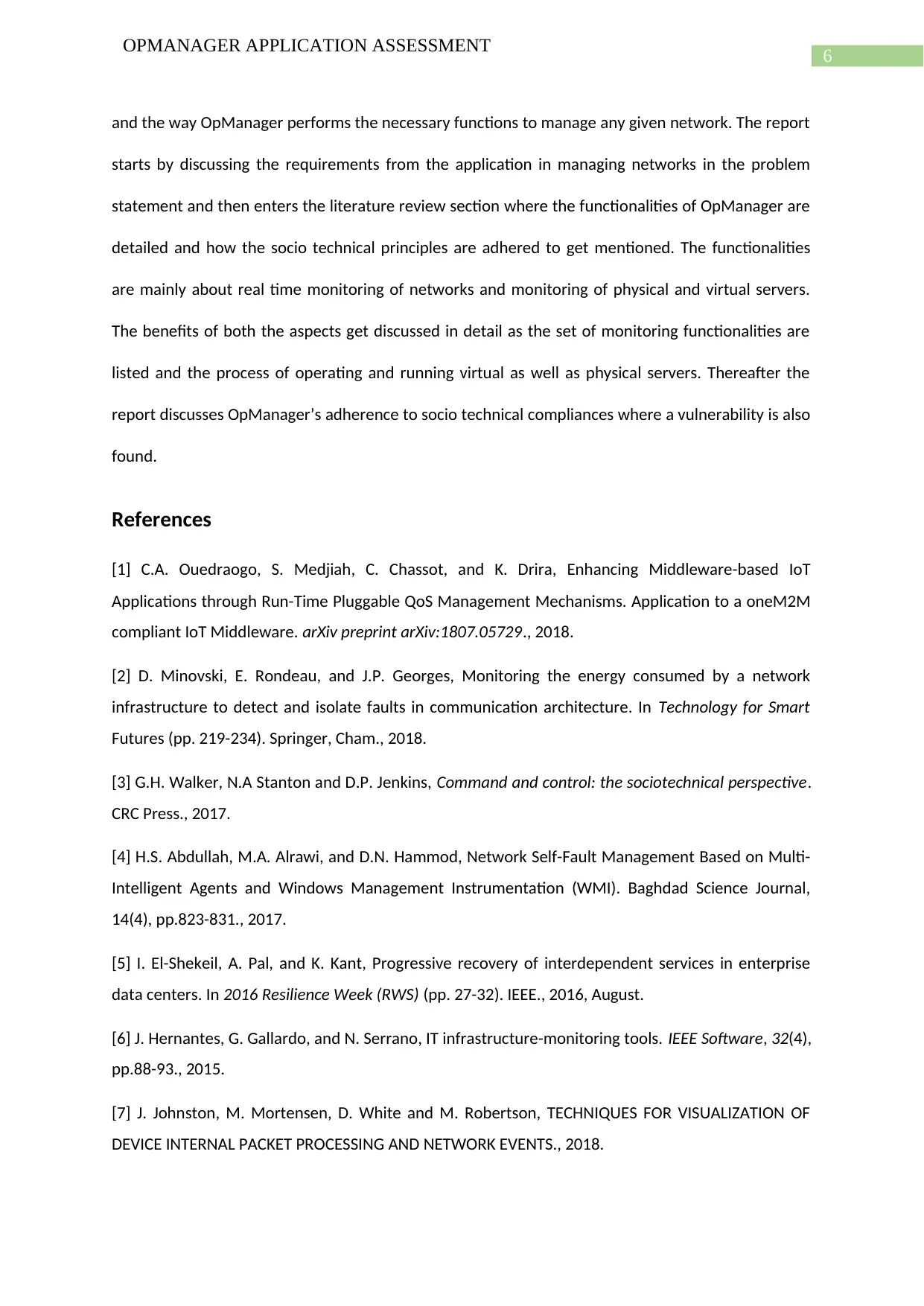
6
OPMANAGER APPLICATION ASSESSMENT
and the way OpManager performs the necessary functions to manage any given network. The report
starts by discussing the requirements from the application in managing networks in the problem
statement and then enters the literature review section where the functionalities of OpManager are
detailed and how the socio technical principles are adhered to get mentioned. The functionalities
are mainly about real time monitoring of networks and monitoring of physical and virtual servers.
The benefits of both the aspects get discussed in detail as the set of monitoring functionalities are
listed and the process of operating and running virtual as well as physical servers. Thereafter the
report discusses OpManager’s adherence to socio technical compliances where a vulnerability is also
found.
References
[1] C.A. Ouedraogo, S. Medjiah, C. Chassot, and K. Drira, Enhancing Middleware-based IoT
Applications through Run-Time Pluggable QoS Management Mechanisms. Application to a oneM2M
compliant IoT Middleware. arXiv preprint arXiv:1807.05729., 2018.
[2] D. Minovski, E. Rondeau, and J.P. Georges, Monitoring the energy consumed by a network
infrastructure to detect and isolate faults in communication architecture. In Technology for Smart
Futures (pp. 219-234). Springer, Cham., 2018.
[3] G.H. Walker, N.A Stanton and D.P. Jenkins, Command and control: the sociotechnical perspective.
CRC Press., 2017.
[4] H.S. Abdullah, M.A. Alrawi, and D.N. Hammod, Network Self-Fault Management Based on Multi-
Intelligent Agents and Windows Management Instrumentation (WMI). Baghdad Science Journal,
14(4), pp.823-831., 2017.
[5] I. El-Shekeil, A. Pal, and K. Kant, Progressive recovery of interdependent services in enterprise
data centers. In 2016 Resilience Week (RWS) (pp. 27-32). IEEE., 2016, August.
[6] J. Hernantes, G. Gallardo, and N. Serrano, IT infrastructure-monitoring tools. IEEE Software, 32(4),
pp.88-93., 2015.
[7] J. Johnston, M. Mortensen, D. White and M. Robertson, TECHNIQUES FOR VISUALIZATION OF
DEVICE INTERNAL PACKET PROCESSING AND NETWORK EVENTS., 2018.
OPMANAGER APPLICATION ASSESSMENT
and the way OpManager performs the necessary functions to manage any given network. The report
starts by discussing the requirements from the application in managing networks in the problem
statement and then enters the literature review section where the functionalities of OpManager are
detailed and how the socio technical principles are adhered to get mentioned. The functionalities
are mainly about real time monitoring of networks and monitoring of physical and virtual servers.
The benefits of both the aspects get discussed in detail as the set of monitoring functionalities are
listed and the process of operating and running virtual as well as physical servers. Thereafter the
report discusses OpManager’s adherence to socio technical compliances where a vulnerability is also
found.
References
[1] C.A. Ouedraogo, S. Medjiah, C. Chassot, and K. Drira, Enhancing Middleware-based IoT
Applications through Run-Time Pluggable QoS Management Mechanisms. Application to a oneM2M
compliant IoT Middleware. arXiv preprint arXiv:1807.05729., 2018.
[2] D. Minovski, E. Rondeau, and J.P. Georges, Monitoring the energy consumed by a network
infrastructure to detect and isolate faults in communication architecture. In Technology for Smart
Futures (pp. 219-234). Springer, Cham., 2018.
[3] G.H. Walker, N.A Stanton and D.P. Jenkins, Command and control: the sociotechnical perspective.
CRC Press., 2017.
[4] H.S. Abdullah, M.A. Alrawi, and D.N. Hammod, Network Self-Fault Management Based on Multi-
Intelligent Agents and Windows Management Instrumentation (WMI). Baghdad Science Journal,
14(4), pp.823-831., 2017.
[5] I. El-Shekeil, A. Pal, and K. Kant, Progressive recovery of interdependent services in enterprise
data centers. In 2016 Resilience Week (RWS) (pp. 27-32). IEEE., 2016, August.
[6] J. Hernantes, G. Gallardo, and N. Serrano, IT infrastructure-monitoring tools. IEEE Software, 32(4),
pp.88-93., 2015.
[7] J. Johnston, M. Mortensen, D. White and M. Robertson, TECHNIQUES FOR VISUALIZATION OF
DEVICE INTERNAL PACKET PROCESSING AND NETWORK EVENTS., 2018.
Paraphrase This Document
Need a fresh take? Get an instant paraphrase of this document with our AI Paraphraser
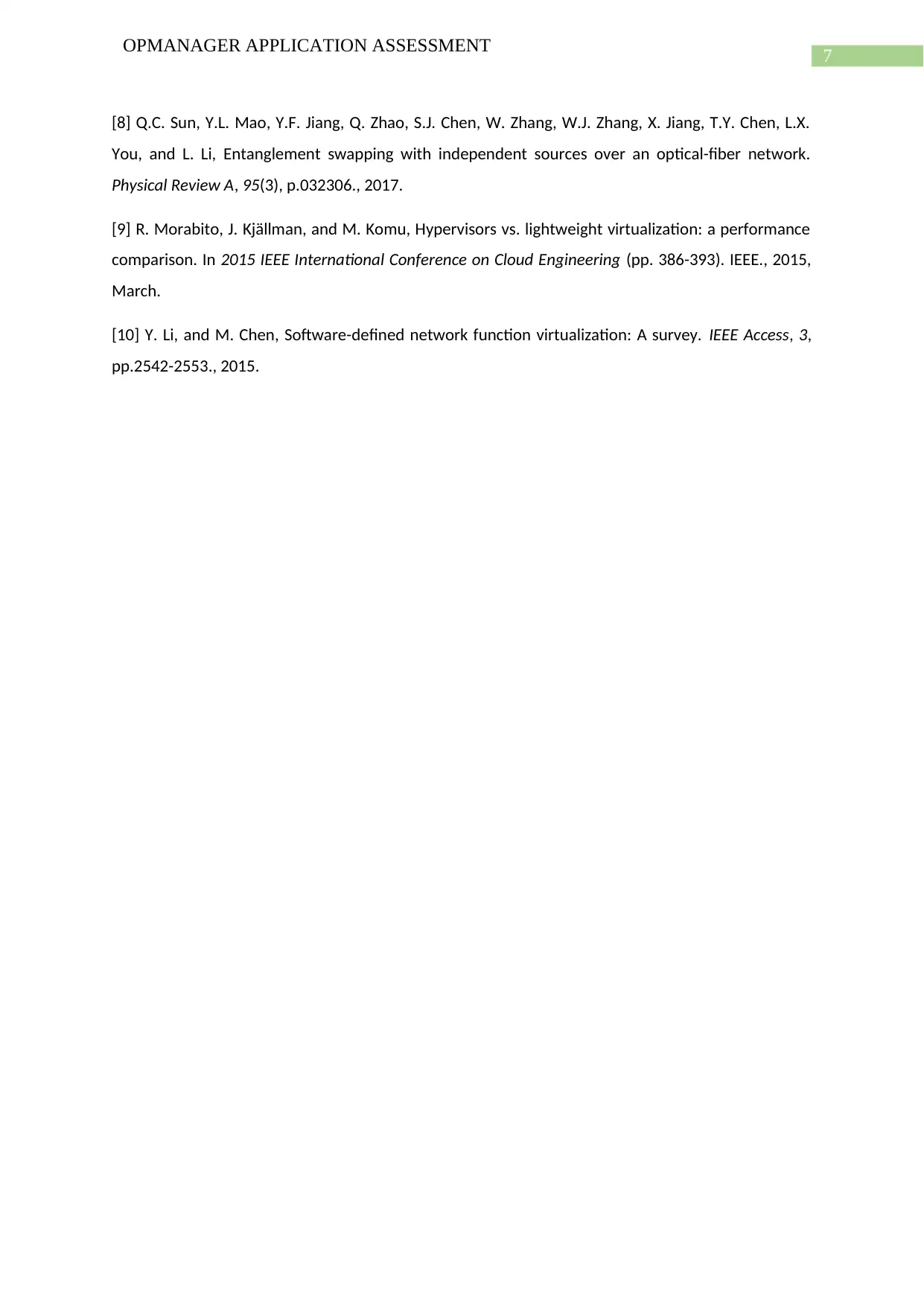
7
OPMANAGER APPLICATION ASSESSMENT
[8] Q.C. Sun, Y.L. Mao, Y.F. Jiang, Q. Zhao, S.J. Chen, W. Zhang, W.J. Zhang, X. Jiang, T.Y. Chen, L.X.
You, and L. Li, Entanglement swapping with independent sources over an optical-fiber network.
Physical Review A, 95(3), p.032306., 2017.
[9] R. Morabito, J. Kjällman, and M. Komu, Hypervisors vs. lightweight virtualization: a performance
comparison. In 2015 IEEE International Conference on Cloud Engineering (pp. 386-393). IEEE., 2015,
March.
[10] Y. Li, and M. Chen, Software-defined network function virtualization: A survey. IEEE Access, 3,
pp.2542-2553., 2015.
OPMANAGER APPLICATION ASSESSMENT
[8] Q.C. Sun, Y.L. Mao, Y.F. Jiang, Q. Zhao, S.J. Chen, W. Zhang, W.J. Zhang, X. Jiang, T.Y. Chen, L.X.
You, and L. Li, Entanglement swapping with independent sources over an optical-fiber network.
Physical Review A, 95(3), p.032306., 2017.
[9] R. Morabito, J. Kjällman, and M. Komu, Hypervisors vs. lightweight virtualization: a performance
comparison. In 2015 IEEE International Conference on Cloud Engineering (pp. 386-393). IEEE., 2015,
March.
[10] Y. Li, and M. Chen, Software-defined network function virtualization: A survey. IEEE Access, 3,
pp.2542-2553., 2015.
1 out of 8
Related Documents
Your All-in-One AI-Powered Toolkit for Academic Success.
+13062052269
info@desklib.com
Available 24*7 on WhatsApp / Email
![[object Object]](/_next/static/media/star-bottom.7253800d.svg)
Unlock your academic potential
Copyright © 2020–2025 A2Z Services. All Rights Reserved. Developed and managed by ZUCOL.





